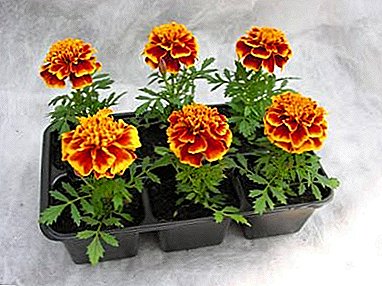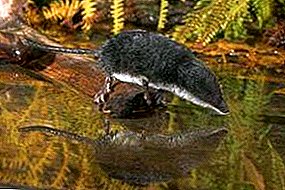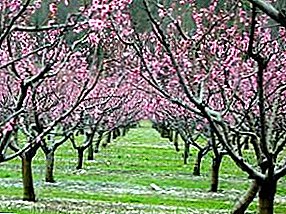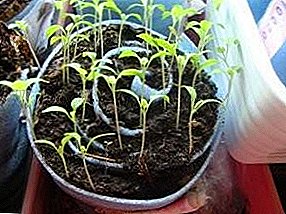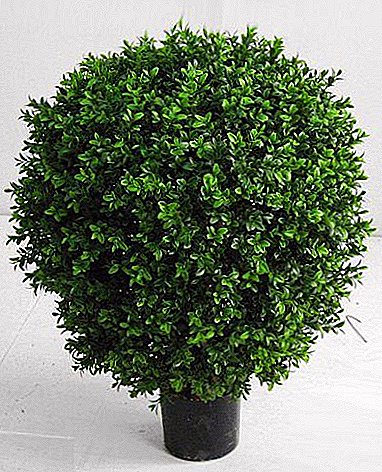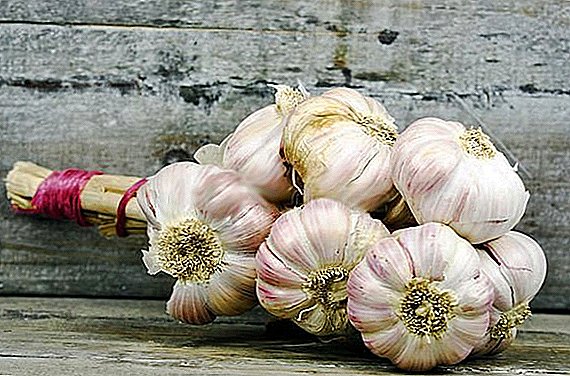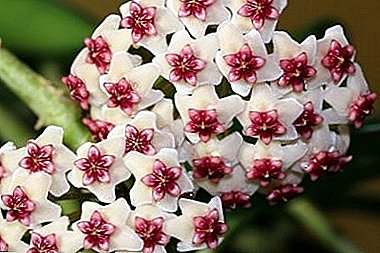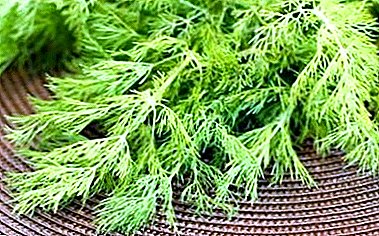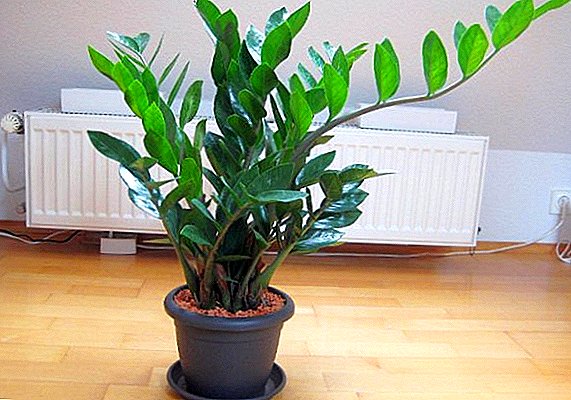 Zamiokulkasa, like any indoor flower, periodically requires a transplant. When and how to do it, with what frequency, about the features of the procedure - read below.
Zamiokulkasa, like any indoor flower, periodically requires a transplant. When and how to do it, with what frequency, about the features of the procedure - read below.
How to understand that zamiokulkas needs a transplant?
Transplanting is a traumatic operation for a plant, and you need to approach it responsibly. Tubers of the root system of the "dollar tree" are vulnerable and require caution when transplanting.
Important! Like all aroids, Zamioculcas is moderately toxic, so you should wear gloves when working with a plant, and at the end wash your hands with soap and water.
Zamioculkas needs a transplant in the following cases:
- After the purchase. The plant needs to adapt to new conditions. But, on the other hand, it can be closely in a pot, where the soil is used for temporary maintenance and is not suitable for further cultivation. The optimal version of the transplant - 2-3 weeks after purchase.
- If the plant is still young (transplanted annually in a pot a little more than the previous one).
- The signal for transplanting an adult plant will be sticking to the surface of the soil and sprouted through the drainage holes.

When and how often should a plant be transplanted?
Transplantation of a "dollar tree" is best done in the spring when active growth begins. To determine how often zamiokulkas need to be transplanted, it is necessary to know the age of the plant. Young copies (up to 3 years) must be replanted every year. Mature plants - as the roots grow and the earth coma is completely filled with the root system (approximately 1 time in 4 years). If the zamiokulkas was purchased in the fall, it is worthwhile to change it in the same season.
Preparing for a transplant
Mature plants, as a rule, are strongly overgrown, which presents a certain difficulty in transplantation. The earth lump is plentifully moistened, and the pot is slightly squeezed from all sides for better extraction of the roots. Transplantation is carried out by the method of transshipment, which ensures the greatest safety of the roots and leaves. During transplantation of large flowers, it is desirable to lay on the side and wrap the leaves with a cloth so as not to break.
Learn how to choose and prepare the land for Zamiokulkas.
Any damage opens the gate for the penetration of infection and parasites, therefore, the places of damage must be treated with turned activated carbon or cinnamon. During the procedure, leaves with tubers can be separated from the bush for further reproduction. The "dollar tree" is also propagated by cutting and feather cutting. 
Pot selection
The choice of the pot should be approached with an understanding of the development of zamiokulkas:
- The aboveground part of the plant begins to grow faster when it is filled with the roots of the entire pot capacity. Therefore, the new capacity should not be much larger than the previous one (approximately 15%).
- The leaves form a vast green mass, and the root system is not large enough to ensure plant resistance. Therefore, the pot should be chosen low and wide, and the leaves to tie. You can put the pot in a planter with a wide base.
- Frequent transplants and vulnerability of the roots tend to choose a plastic pot, which, if necessary, can be cut, keeping the root system intact.
Did you know? Zamioculcas is considered the symbol of the Chinese New Year, and in China it is called the "golden tree".
Soil preparation and drainage
Zamiokulkas will need light, loose, moisture- and breathable soil, which can be bought in the store (marked "for succulents and cacti") or cooked by mixing equal parts of peat, coniferous and leafy ground, coarse sand. Sand can be replaced by perlite or zeolite.
The acidity of the soil mixture should be neutral, the substrate should not contain much organic matter. You can not use clay soil that does not provide aeration of the root system. 
Step-by-step guide transplant "dollar tree"
After preparing the pot and soil for transplanting, you can proceed to the process.
The sequence of actions is as follows:
- At the bottom of the tank pour 2 cm of drainage material - expanded clay, broken brick without dust, pebbles, broken foam.
- Then, with a prepared primer, fill the planting container with a third and place an earthen clod of zamiokulkas in the center. It is not necessary to clean the roots from the previous soil. The only thing that needs to be done is to inspect the roots for rotting.
- Add soil, leaving the top tubers on the surface and slightly compact the soil.
- If sphagnum moss is laid over the ground, it will save the ground from drying out.
- After transplanting, pour the plant abundantly before water flows through the drainage, free the tray from water to avoid stagnation.
- Place the transplanted plant in a semi-dark place for several days to adapt.
- Moderate watering after 3 days and move Zamiokulkas to a permanent place.
Important! When transplanting zamiokulkas, the upper tubers should remain about 1 cm above the soil surface. Fully sprinkle them with soil can not.
Aftercare after transplant
It should be remembered that after transplantation, the plant needs to adapt to the new soil and pot, so there may be growth retardation or yellowing of the leaves.
Location
When leaving after transplantation, you need to know the needs of the plant in moisture, in the temperature of the content, the illumination of the location:  Temperature:
Temperature:
- summer - within + 18 ... + 24 ° C. If the temperature rises above + 28 ° C indoors, regular ventilation is necessary;
- in the winter - it is desirable to provide content in a cool room with a temperature of + 16 ... + 18 ° C, but not below + 12 ° C.
Illumination:
- for a zamiokulkas it is necessary a bright place with a diffused light, but remember that not always the plant can be located on a window sill. With a high growth it is placed on the floor, and this changes the illumination;
- with a long daytime light in the summer season, windows of the eastern and northern directions are suitable; it can be brought to the open air with a slight tint;
- in winter, it should be placed closer to the south window, with a lack of light, the plant should be lit up with phytolamps.
Important! When exposed to direct sunlight in a hot time on the leaves burns. Shading is a way out of this situation.
Zamioculcas does not require spraying, but for aesthetic appearance and for the prevention of pests, the leaves must be regularly cleaned with a soft, damp cloth or washed with a warm shower, covering the ground from excessive wetting.
Watering
Having succulent roots, Zamiokulkas does not suffer from dry air and lack of moisture. Watering is carried out rarely, just making sure the soil dries out (about once a week). Water plentifully before the flow of water through the drainage holes, then release the pan from excess water.  In winter, watering is reduced to a minimum, depending on the position of the flower relative to heating devices and dry air in the room.
In winter, watering is reduced to a minimum, depending on the position of the flower relative to heating devices and dry air in the room.
Fertilizer
As with any plant, Zamiokulkas require nutrients during the growth period, and fertilization is carried out at the beginning of leaf growth from April every three weeks. For top dressing it is better to use special fertilizers for succulents and cacti, where the composition of nutrients and microelements is properly balanced and the acidity of the soil is taken into account.
Did you know? It is believed that zamiokulkas can not be taken as a gift - you need to pay a small, purely symbolic fee. Only in this case, the flower will acquire magical abilities and bring wealth to the owner.
When using fertilizers for indoor plants, the concentration is reduced by 2-3 times.
Possible problems
Under adverse conditions, violation of conditions of detention and infection from neighboring flowers, the following problems may arise:
- yellow leaves - excess or lack of moisture, temperature and drafts, aging, overdose of fertilizers;
- dark spots on the leaves - excess and stagnant moisture, low temperature;
- dry yellow spots on the leaves - sunburn;
- leaves dry up and fall off - the aging process is natural if new ones appear;
- leaves are drawn, the number of feathers decreases, they are weak and close planted - lack of coverage during the period of growth;
- root is rotting - lack of light and excess moisture;
- slow growth and lack of new shoots - lack of light, cramped capacity, depth of landing;
- branch broke off - remove with a sharp knife and sanitize the cut with activated carbon or cinnamon;
- may be attacked by pests (aphid, spider mite, scale) - at the first signs of infection, treat the flower with directional insecticides.
 Despite the fact that zamiokulkas can hardly be called a flowering plant due to the rare appearance of inflorescences, it pleases with an abundance of dark green glossy leaves. With proper care and compliance with the necessary conditions of detention, it will look spectacular and decorative in any room.
Despite the fact that zamiokulkas can hardly be called a flowering plant due to the rare appearance of inflorescences, it pleases with an abundance of dark green glossy leaves. With proper care and compliance with the necessary conditions of detention, it will look spectacular and decorative in any room.Video: how to transplant Zamioculcas


